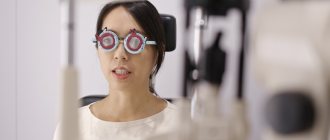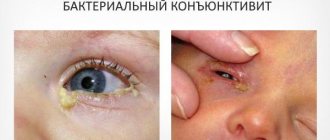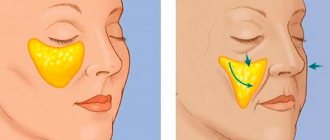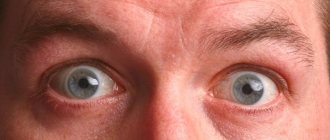The degree of myopia is the lens that needs to be placed in front of the eye to bring focus to the retina of the elongated eye. It is measured in diopters.
- Low myopia (up to -3.0 D)
: the eye does not change structurally, and all you need is to choose good glasses or lenses - Moderate myopia (3.5-6.0 D)
: “yellow light”, you need to be alert - High myopia (>6.0 D)
: high risks of complications
For example, with slight myopia, the eyeball lengthens by less than 0.5 mm
, the image becomes unclear, but sufficient to distinguish 2-3 lines of the table.
In glasses -1.5 D,
the focus is again on the retina, and the person sees at
1.0
. The longer the eye, the more distance visual acuity decreases and the larger the lens must be placed in front of the eye to achieve proper focus. Accordingly, the higher the myopia and, most importantly, the greater the risk of developing its complications.
Degrees of myopia
There is a generally accepted gradation of myopia according to the severity of the condition, which includes 3 degrees:
- Weak - visual impairment up to -3.0 diopters (D) inclusive;
- Average - from - 3.25 D to - 6.0 D;
- Strong - from - 6.0 D or more.
A weak degree of the disease, according to scientists, in most cases can be attributed to the so-called accommodative myopia, which is considered a manifestation of the eye’s adaptation to work that requires viewing objects or text at a very close distance, while simultaneously weakening the eye’s accommodation mechanisms.
The progression of mild myopia indicates the possibility of turning a visual defect into a serious disease. At the same time, it is difficult to say how much is the upper limit of a high degree of myopia, since some patients may have cases of the disease with impairment values within the range of -25 D and above.
High degree of myopia and astigmatism
Quite often, high myopia is accompanied by astigmatism. Moreover, if myopia exceeds -15 D, then there are contraindications for laser correction. How to restore vision in such a situation?
In such cases, specialists combine several types of surgical intervention. First, an intraocular lens is implanted, which helps correct myopia, and then astigmatism is corrected using laser equipment.
Accommodation process
Accommodation, or a change in the curvature of the lens, is carried out thanks to the simultaneous balanced work of the ciliary muscle (another name is the ciliary muscle), the ligament of cinnamon (or the ciliary girdle) and the lens itself. The result is the focusing of light rays on the retina and the appearance of a clear image of the object. To put it simply, when examining objects that are nearby, the muscles tense and the lens moves into the anterior chamber of the eye. At the same time, its curvature increases, the pupil narrows. To view distant objects, the eye muscles relax, the lens takes on a flatter shape, and the pupil dilates. This is how the refractive power of the lens is adjusted.
If disturbances in the balanced operation of this mechanism occur, the optimal mode of adaptation of the eye to viewing objects at different distances fails. With myopia, the mechanism of accommodation undergoes complex changes; the lens (which is quite plastic up to 40 years of age) elongates in length and is able to fix this position. It is the increase in the length of the eyeball that causes the retina, on which the image should be focused, to be outside the required focal plane. The human brain receives a blurred image of distant objects.
Causes of myopia
Scientists believe that an increase in the length of the eyeball has a genetic predisposition, but it can be triggered by the following unfavorable factors:
- Spasm of the ciliary muscle resulting from its overstrain.
- Keratoconus is a change in the shape of the cornea.
- Injuries to the lens causing its displacement.
- In old age - lens sclerosis.
Additional factors causing myopia are:
- Abnormal visual load when working with objects at close range.
- Intense strain on the eyes at an early age, especially associated with the use of gadgets.
- Poor physical development.
- Insufficient exposure to fresh air/open space.
- Poor illumination of the workplace, lack of sunlight.
- Changes in the endocrine system during adolescence.
- Poor nutrition leading to hypovitaminosis, especially lack of nutrients such as calcium, zinc, selenium.
The above factors are the main, but far from exhaustive, causes of myopia.
Treatment of myopia
Many patients wonder how to treat high myopia.
There are several methods to improve vision in case of high myopia.:
- Glasses. For most people with high myopia, glasses are the main and safest method of vision correction; they wear them all the time.
- Contact lenses. For some patients with high myopia, contact lenses provide clearer and wider vision than glasses. Since lenses are worn directly on the eyes, proper lens care is necessary to prevent complications.
- Refractive surgery. With the help of certain operations, you can change the shape of the cornea and correct myopia. The most common surgeries are photorefractive keratectomy (PRK) and LASIK. In PRK, the ophthalmic surgeon removes a thin layer of tissue from the surface of the cornea to change its shape, allowing light rays to focus on the retina. With LASIK, the doctor uses a laser to remove the inner layers of the cornea. In order to do this, you must first separate the surface layer of the cornea, which, after removing the internal tissues, returns to its place.
- Implantation of phakic intraocular lenses is a relatively new method of treating high myopia. Special artificial lenses are placed inside the eyeball to correct the refraction of light rays.
It should be noted that surgical treatments for high myopia can only be performed in adults.
Optical correction of myopia
Based on modern research on the pathogenesis and clinical picture of myopia, scientists have formulated recommendations for optical correction of this disease at stages I and II degrees of severity, as well as for uncomplicated grade III myopia, in order to prevent worsening of the condition.
For stationary mild/moderate myopia, complete vision correction is prescribed to preserve the visibility of distant objects. In the case when progressive myopia of the first 2 degrees is diagnosed, hypercorrection (minor) is recommended to ensure binocular visual acuity within 0.7 - 0.8. The preferred choice when determining means of vision correction are corneal contact lenses, the use of which creates favorable conditions for the normalization of accommodation mechanisms.
Important! For mild myopia, it is recommended not to use vision correction products all the time, but only when the need arises.
In order to see close objects clearly, it may be necessary to prescribe two types of corrective aids. This may be necessary when the accommodative mechanism of the eye is significantly weakened. In such cases, it is necessary to prescribe either a second pair of glasses or bifocal glasses (contact lenses), the lower half of which has weaker diopter values. The more severe the disease, the more significant the difference in performance between the upper and lower halves of the lenses is required; accordingly, the more dramatic the transition within a single lens.
In this case, for greater comfort, modern medicine suggests using multifocal optical or contact lenses that have a smooth transition of diopters from the top to the bottom.
For severe myopia (from - 6.0 D), permanent full vision correction is prescribed. In the event that the patient has high unilateral myopia or the difference in different eyes is very large (such a disorder is called anisometropia), as well as when there are manifestations of astigmatism (1.0 diopters or more), when prescribing a correction, the most comprehensive consideration of all associated factors is required. factors. In all of the above cases, preference is given to soft contact lenses, since they are well tolerated. Sometimes it is necessary to make custom contact lenses. It is necessary to understand that, in addition to optical vision correction, to prevent an increase in the symptoms of the disease, it is necessary to maintain a healthy lifestyle, nutritious nutrition, and engage in sports that are not contraindicated for this disease (for example, swimming). The comprehensive importance of these aspects is necessarily revealed by the attending physician observing a patient with myopia.
Symptoms
The main symptoms of myopia complicated by astigmatism usually appear gradually, the disease has a strong tendency to progress if left untreated.
The pathology is characterized by the following symptoms:
- visual acuity decreases;
- duality and blurriness of the image appears;
- inability to concentrate attention on a specific object;
- decreased vision at long distances;
- fast fatiguability;
- increased tearing of the eyes;
- chronic headaches and dizziness caused by changes in intraocular pressure.
When the first signs of the disease appear, you should contact an ophthalmologist for further diagnosis and choice of treatment. In children, it is more difficult to determine the symptoms, since myopic astigmatism can be congenital.
If there is a pathology, the child always brings the object close to his eyes to examine it in detail. Astigmatism can be an absolute reason for unfitness to drive a car or perform military service. The health category is assigned depending on the degree of visual impairment.
People diagnosed with myopic astigmatism must hold objects very close to their eyes to see them. Myopia and myopic astigmatism: similarities and differences. Myopic astigmatism and myopia are often confused, since the symptoms of the diseases are similar, especially when the pathology is present in both eyes.
With myopic astigmatism, as with myopia, the image appears in front of the retina. But there are differences between them. With myopic astigmatism, the shape of the cornea changes, and with myopia, there is a change in the size and shape of the eyeball.
When diagnosing myopia in newborns, its stable course is noted. Children with congenital myopia need constant attention from doctors. Parents need to remember that regular examination of the child provides an opportunity to observe the disease over time.
Timely optical correction will prevent its progression. Myopia, congenital and acquired, is distinguished by certain symptoms without a clearly defined clinical picture. Among the symptoms of the pathological condition of the eyeball, regardless of the time of its formation, it should be noted:
- the appearance of squinting in children;
- decreased distance visual acuity;
- the appearance of a feeling of itching and pain in the eyes;
- the desire in children to bring toys, objects, books closer to their eyes;
- the appearance of divergent strabismus in babies 6 months of age;
- increased frequency of eyelid blinks in young children;
- a noticeable manifestation of rapid fatigue of the visual apparatus.
Children cannot complain to their parents about poor vision due to a lack of understanding of the difference between good and bad vision. In this regard, adults are obliged to constantly monitor the child’s behavior, his posture, and also determine the reasons for his anxiety.
If you notice headaches, rubbing of the eyes, or frequent blinking of the eyelids, it is recommended to immediately contact an ophthalmologist. He will be able to diagnose the pathology, identify the extent of damage to the eyeball, and also prescribe the correct treatment.
Timely identification of the disease and constant monitoring by a doctor provide an opportunity to exclude serious complications, progression of the disease, as well as disability of the child. Treatment of the disease at an early stage of its development allows you to obtain the expected positive result.
Medication correction
Medications that affect the accommodation of the eye and improve the performance of the eye muscles (primarily the ciliary muscle) are designed mainly to prevent the worsening of myopia and prevent the occurrence of complications. To slow down the progression of the disease, it is recommended to systematically (at least 2 times a year) take a course of drugs that help strengthen the sclera and enhance the metabolic processes of the choroid and retina of the eye.
The selection of medications is carried out by an ophthalmologist, taking into account the individual characteristics of the patient.
In order to treat progressive myopia, a non-surgical method of strengthening the sclera is sometimes used, which is the introduction of a medical drug contained in a foamed polymer composition onto its surface. Such strengthening injections are designed to increase the strength of the sclera with progressive myopia. The appropriateness of using this therapy is determined by the attending physician.
Laser surgery for moderate and high myopia
The most popular type of surgical intervention is laser vision correction, which allows you to work with myopia down to -15 D. The operation is performed without mechanical impact on the cornea, using laser equipment. The scalpel beam vaporizes the corneal tissue. This operation can be performed only if there are indications determined by an ophthalmologist. The decision to perform laser surgery is made based on the results of an individual examination, which helps to exclude contraindications.
Complications
Severe myopia may be accompanied by the following complications:
- Atrophy of the inner membranes of the fundus of the eye: the formation of cracks in the choroid of the fundus, fragility of blood vessels, leading to the appearance of hemorrhages in the retina or under it.
- Retinal dystrophy: thinning of the retina, accompanied by its breaks.
- Vitreous detachment: destructive changes in the vitreous (the clear, gel-like substance that fills the space between the retina and the lens).
- Retinal detachment: the appearance of breaks in the retina of the eye, as well as its separation from the choroid, close contact with which is the key to visual acuity.
- Strabismus: a binocular vision disorder caused by increased stress on the internal rectus muscles of the eye.
This usually happens when the disease is advanced or due to treatment errors. Complicated myopia is one of the main causes that can cause vision loss, even disability.
Operative methods of correction
In cases where severe myopia continues to progress, surgical intervention is often necessary. How many options for surgical treatment of severe myopia are offered by ophthalmology clinics today:
- Laser correction - modeling the required shape of the cornea using laser exposure;
- Phakic lens implantation - installation of a corrective lens directly into the patient's eye, usually behind the iris in front of the lens;
- Keratoplasty - transplantation of a donor cornea;
- Refractive lens replacement - implantation of an artificial lens.
Each surgical treatment option has its own advantages and disadvantages, as well as a sufficient number of contraindications. Therefore, you can resort to such methods only after receiving complete information and carefully weighing all the pros and cons.
A disease such as severe myopia requires balanced, timely treatment that takes into account the individual characteristics of the patient’s body, his age, and lifestyle.
Useful video
The following video links provide more information about congenital myopia:
Hereditary myopia can be treated. If you follow your doctor's recommendations, it is quite possible to maintain good vision.
Author's rating
Author of the article
Alexandrova O.M.
Articles written
2029
about the author
Was the article helpful?
Rate the material on a five-point scale!
If you have any questions or want to share your opinion or experience, write a comment below.











